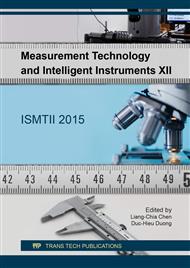[1]
J. Cho, K. Konopka, K. Rozniatowski, E. Garcia-Lecina, M. S. P. Shaffer, and A. R. Boccaccini, Characterisation of carbon nanotube films deposited by electrophoretic deposition, CARBON, 2009, vol. 47, p.58–67.
DOI: 10.1016/j.carbon.2008.08.028
Google Scholar
[2]
B. O'. Regan and M. Grätzel, A low-cost, high-efficiency solar cell based on dye-sensitized colloidal TiO2 films, Nature, 1991, pp.353-737.
DOI: 10.1038/353737a0
Google Scholar
[3]
G. Smestad, C. Bignozzi, and R. Argazzi, Testing of dye sensitized TiO2 solar cells I: Experimental photocurrent output and conversion efficiencies, Sol. Energy Mater. Sol. Cells, 1994, vol. 32, p.259.
DOI: 10.1016/0927-0248(94)90211-9
Google Scholar
[4]
Z. Q. Lin, Y. K. Lai, R. G. Hu, J. Li, R. G. Du, and C. J. Lin, A highly efficient ZnS/CdS@TiO2 photoelectrode for photogenerated cathodic protection of metals, Electrochim Acta, 2010, vol. 55, p.8717.
DOI: 10.1016/j.electacta.2010.08.017
Google Scholar
[5]
H. J. Tian, L. H. Hu, W. X. Li, J. Sheng, S. Y. Xu, S. Y. Dai, and J. Mater, Superior energy band structure and retarded charge recombination for Anatase N, B codoped nano-crystalline TiO2 anodes in dye-sensitized solar cells, Chem. Commun, 2011, vol. 21 p.7074.
DOI: 10.1039/c2jm16896k
Google Scholar
[6]
P. Sudhagar, J. H. Jung, S. Park, R. Sathyamoorthy, H. Ahn, and Y. S. Kang, The performance of coupled (CdS: CdSe) quantum dot-sensitized TiO2 nano fibrous solar cells, Electrochim. Acta, 2009, vol. 55 p.113.
DOI: 10.1016/j.electacta.2009.08.015
Google Scholar
[7]
W. Y. Fu, H. B. Yang, P. Sun, Y. Y. Zhang, L. R. Wang, W. Y. Zhao, H. Zhao, et, al. Chemical bath deposition of Cu2O quantum dots onto ZnO nano rod arrays for application in photovoltaic devices, RSC Advances, 2015, vol. 30, pp.23401-23409.
DOI: 10.1039/c4ra13776k
Google Scholar
[8]
G. Zhu, L. Pan, T. Xu, Q. Zhao, B. Lu, and Z. Sun, Microwave assisted CdSe quantum dot deposition on TiO2 films for dyesensitized solar cells, Nanoscale, 2011, vol. 3, p.2188.
DOI: 10.1039/c1nr10068h
Google Scholar
[9]
J. Z. Chen, B. Li, J. F. Zheng, J. H. Zhao, H. W. Jing, and Z. P. Zhu, Polyaniline nano fiber/carbon film as flexible counter electrodes in platinum-free dye-sensitized solar cells, Electrochim Acta, 2011, vol. 56, p.4624.
DOI: 10.1016/j.electacta.2011.02.097
Google Scholar
[10]
X. Z. Liu, Y. H. Luo, H. Li, Y. Z. Fan, Z. X. Yu, Y. Lin, et al., Ce phosphors as a scattering layer for high-efficiency dye sensitized solar cells, Chem. Commun, 2007, vol. 27 p.2847.
Google Scholar
[11]
W. Guo, Y. H. Shen, G. Boschloo, A. Hagfeldt, and T. Ma, Influence of nitrogen dopants on N-doped TiO2 electrodes and their applications in dye-sensitized solar cells, Electrochimica Acta, 2011, vol. 5, p.4611–4617.
DOI: 10.1016/j.electacta.2011.02.091
Google Scholar
[12]
W. Shao, F. Gu, L. L. Gai, C. Z. Li, et al., Forest-like TiO2 hierarchical structures for efficient dye-sensitized solar cells, Chem. Commun, 2010, vol. 22, p.6824.
DOI: 10.1039/c2jm15442k
Google Scholar


